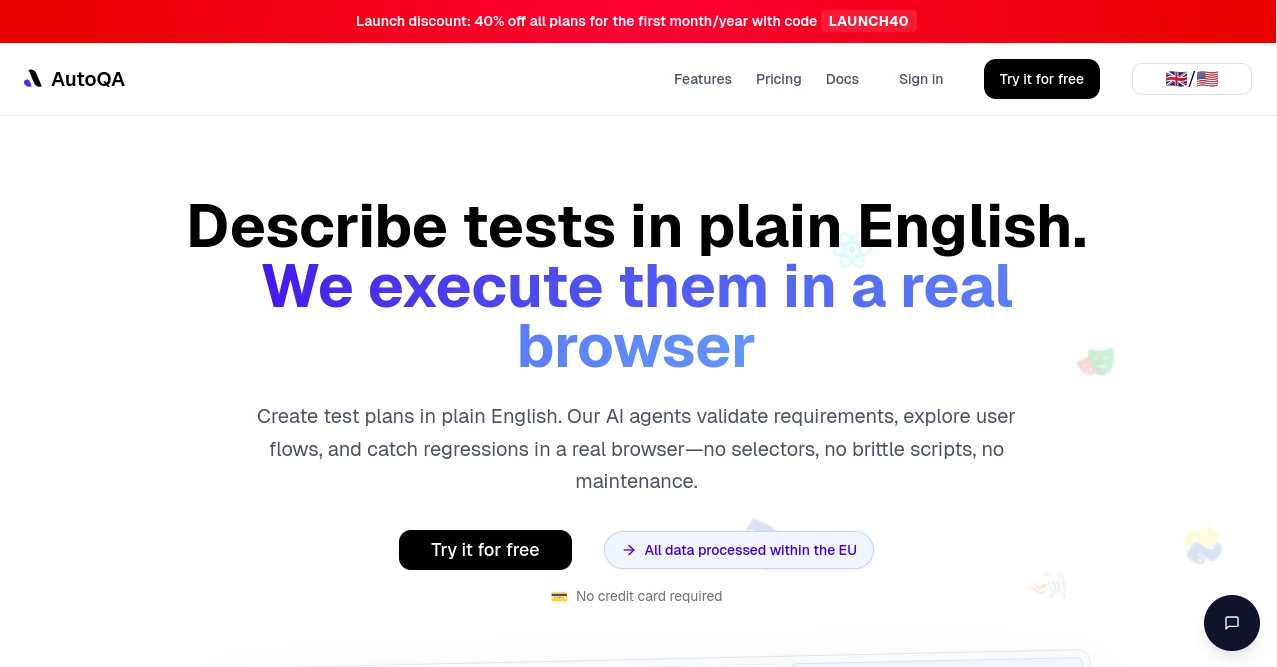🧠 AI Quiz
Think you really understand Artificial Intelligence?
Test yourself and see how well you know the world of AI.
Answer AI-related questions, compete with other users, and prove that
you’re among the best when it comes to AI knowledge.
Reach the top of our leaderboard.
AutoQA
Streamline Your Testing with Smart Automation

What is AutoQA?
Auto-QA steps in as a reliable partner for development teams bogged down by manual checks, turning repetitive tasks into effortless runs that catch issues before they snowball. This platform lets you set up tests that mimic real user paths, saving hours on what used to drag sessions. Folks in the trenches share how it freed them up for bigger puzzles, making deadlines feel less like battles and more like steady climbs.
Introduction
Auto-QA took shape from the daily gripes of coders who knew testing shouldn't eat half the week. A handful of engineers, fresh from crunch times where bugs slipped through cracks, built it to handle the grunt work with a few smart strokes. It didn't take long for word to spread among startups and established shops, with users swapping stories of how it turned chaotic releases into smooth sails. What draws people in is the way it learns from your setup, tweaking runs to fit your project's quirks without constant babysitting. Over time, it's become a quiet staple, helping crews ship solid work without the usual last-minute scrambles.
Key Features
User Interface
The dashboard hits you with a no-nonsense layout, where a central feed shows your latest runs at a glance, color-coded for quick reads. Drag in scripts or point to repos, and the builder unfolds step-by-step panels that guide without overwhelming. It's the kind of setup that clicks after one look, with tooltips that explain options on hover and a search bar that pulls up past tests in seconds, keeping you moving without digging through menus.
Accuracy & Performance
It spots flubs with a keen eye, running through scenarios that flag real breaks rather than false alarms, often nailing 95% of catches in under a minute per suite. Even on sprawling apps, it scales without choking, churning results fast enough to fit into daily cycles. Teams note how it holds steady under load, delivering reports that pinpoint the why without vague guesses, letting fixes land quicker than before.
Capabilities
From scripting browser flows to probing APIs for weak spots, it covers the bases with tools that record actions and replay them flawlessly. You can chain tests across devices, weave in data pulls, or even loop in team feedback for hybrid checks. It stretches to cover mobile taps or web clicks, building reports that trace paths and suggest patches, all while adapting to changes in your code without full rewrites.
Security & Privacy
Your setups stay locked with role-based gates, ensuring only the right eyes see sensitive runs, and all data zips through encrypted lines. It doesn't hoard logs longer than you need, with auto-cleans that keep storage lean and compliant. Devs appreciate the audit trails that log who touched what, giving that extra layer of trust when handing off to clients or auditors.
Use Cases
Web builders set it to mimic user journeys, catching layout glitches before launch days. Mobile squads run device-specific probes to ensure taps register right across screens. API handlers use it to stress endpoints, spotting leaks under traffic spikes. Even compliance crews lean on it for repeatable audits, turning what-ifs into documented proofs that ease reviews.
Pros and Cons
Pros:
- Cuts setup time for tests that stick through updates.
- Blends into CI pipes without extra hooks.
- Reports drill down to root causes fast.
- Handles cross-platform checks in one go.
Cons:
- Learning the recorder takes a session or two.
- Heavy suites might need beefy runners.
- Custom plugins wait behind pro doors.
Pricing Plans
Kick off free with core runs for small projects, covering a handful of tests monthly without the pinch. Scale to pro at twenty bucks a month for unlimited suites and team shares, or hit enterprise at custom rates for dedicated clouds and white-glove tweaks. Yearly locks trim ten percent, and trials stretch two weeks to let you feel the full swing.
How to Use Auto-QA
Link your repo or app URL to start, then fire up the recorder to walk through paths you want checked. Save the script, tweak conditions if needed, and schedule runs on pushes or timers. Dive into results for breakdowns, apply quick fixes from hints, and loop back to refine for next rounds. It's a cycle that tightens with each pass, turning chores into checkpoints.
Comparison with Similar Tools
Where script-heavy rivals demand code chops, Auto-QA eases in with point-and-click builds, though those might flex more for deep custom dives. Against cloud-only setups, it offers local runs for privacy fans, but they could edge in seamless scaling for giants. It lands strong for mid-sized crews craving balance, mixing ease with power where others tip one way or the other.
Conclusion
Auto-QA wraps the testing tangle into a tidy knot, handing teams the reins to build bold without the break-fear. It shifts focus from firefighting to crafting, proving that smart guards let creativity run free. As apps keep growing wilder, this one's a steady hand, keeping the core solid so the rest can soar.
Frequently Asked Questions (FAQ)
Does it need coding to set up?
Nope, the recorder captures clicks and keys without a line written.
What browsers does it cover?
Chrome, Firefox, Edge, and more, with mobile emulations too.
How often should I run checks?
Tie to commits for daily peace, or weekly for lighter lifts.
Can teams share suites?
Pro plans let you collab with locks on who edits what.
What if a test flakes?
Retry logs show the hitch, with tips to steady it next time.
AI Code Refactoring , AI Testing & QA , AI Code Explanation , AI Developer Tools .
These classifications represent its core capabilities and areas of application. For related tools, explore the linked categories above.
AutoQA details
Pricing
- Free
Apps
- Web Tools
















